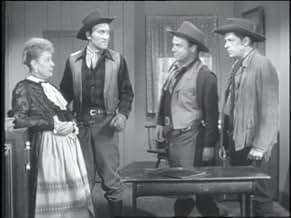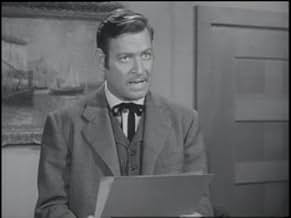Aggiungi una trama nella tua linguaThe adventures of the masked Texas Ranger and his Native American partner.The adventures of the masked Texas Ranger and his Native American partner.The adventures of the masked Texas Ranger and his Native American partner.
- Candidato a 2 Primetime Emmy
- 3 candidature totali
Recensioni in evidenza
As an adult and watching the earliest episodes, it occurred to me that Tonto, actually gave all the idea's for his partners image. It was Tonto that suggested the mask. It was Tonto that suggested the silver bullets, and it was Tonto that came up with the name for Silver..when he proclaimed that the horse the Lone Ranger saved from death was "Silver White"! At last, as Tonto stood with the lone surviving Ranger over the graves of the others, Tonto, proclaimed "You are all alone now..You Lone Ranger! Of course, the response was "Yes Tonto, I am..The Lone Ranger!
The bonds of friendship and trust for the Lone Ranger and Tonto, was used 25 years later as an example of true friendship in an episode of Happy Days. In this particular episode, where Ritchie wanted to expose Fonzie for hating liver. The remark from Fonzie that typified what a true friendship should be was this "Many people tried to remove the mask of the Lone Ranger, but Tonto "never tried". All of America knew and felt that the truest of friendships would be to be like The Lone Ranger and Tonto.
Clayton Moore and Jay Silverheels are beloved for more than just being actors in a great western that will live forever. They are symbolic of so much more and as I said..will always be my hero's.
I suspect that most people reading this will have at least some knowledge of this series, but I'll give a brief synopsis of it anyway. A group of six Texas Rangers go riding after an outlaw gang (the Cavendish Gang). The Rangers are being led into a trap by a scout who is working for the gang and five of them are killed in an ambush. The sixth, a man named Reid, survives, in no small part due to the help of an Indian named Tonto who, in a twist of an improbable nature, met him once before, when Tonto was a boy. Reid helped him then and he returns the favor, calling Reid "Kemo Sabe".
Reid recovers and decides to take up a secret identity to track down and bring to justice bad guys. He dons a black mask and a white hat, calling himself "The Lone Ranger". He saves and then tames a wild white stallion he calls Silver. Having a secret silver mine, he covers his expenses and manufactures silver bullets from the ore taken from the mine. Thus is a hero born.
Clayton Moore played the title character most of the series, though John Hart assumed the role for 52 episodes after the first 78 were produced. When Hart wasn't accepted as the character by audiences, Moore returned. Jay Silverheels played Tonto for the entire run, appearing in virtually every episode. Lots of recognizable faces appeared in the series, most of them before they became famous, like DeForrest Kelly, pre-Star Trek and Victor Sen Yung, pre-Bonanza.
This series is available on DVD, most notably the Classic Media The Lone Ranger: Collector's Edition, a 30 disc release containing all 221 episodes. The set is excellent and well worth having if you're a fan. Recommended.
Along with William Boyd's Hopalong Cassidy TV series, which was first telecast on NBC on June 24, 1949, it was among the earliest TV western series. Hopalong Cassidy actually debuted in 1948, when Boyd syndicated his films to NBC. (In 1947, Boyd had bought to the rights to his Hoppy films.)
Fran Stiker and George W. Trendle created the Lone Ranger as a local radio program in 1933. It quickly went nationwide and was the cornerstone of the old Mutual Radio network. Ironically, Hopalong Cassidy was also a Mutual radio program.
When The Lone Ranger was brought to TV in 1949, many of the radio plays were adapted to the younger medium. As a consequence, many of the earliest episodes show their radio origins with the use of a narrator who links the different scenes together. The Lone Ranger was the biggest hit on the new ABC network in its early years.
The first three episodes told the the familiar story of how the Lone Ranger came to be, his connection to Tonto, and the origins of his prize horse Silver. Glenn Strange played the villain Butch Cavandish in these episodes.
The Lone Ranger was also one of the earliest shows to film mostly outdoors. Starting in 1956, the Wrather Company began filming the program in color.
The Cisco Kid, starring Duncan Renaldo and Leo Carrillo had been filmed in color since its first aired in 1950. Jack Wrather, however, was more concerned about the competition to his kid's show from the new adult westerns that had began to appear on TV.
When the Lone Ranger appeared, The New York Times critic Jack Gould ripped the show, as "just another Western, and not a notably good one at that." Gould considered the first three episodes manipulative, mostly because of the cliffhanger endings of the first two episodes. The New York Times writer accused everyone associated with the program of keeping children "emotionally hopped upped." As a result of his criticisms, the cliffhanger type endings were never used after the first two episodes. Gould, however, had been suffering from a misunderstanding. The show had never intended to be broadcast as a serial despite the serial background of its star Clayton Moore.
In 1952, B-film actor John Hart replaced Clayton Moore. Moore had threatened to quit after 1950. He was being paid only $500 an episode for his hit show, and wanted a substantial raise. Audiences rejected Hart in the role, and after 36 episodes Moore was back atop Silver.
The Lone Ranger was the first Western Hit on TV.
The series was filmed in both Utah and in California.
There can be no denying that The Lone Ranger is the quintessential TV Western of the 1950s. It is the one show that has proved, time and again, to be a real favorite of both children and adults alike.
Starring Clayton Moore, as the masked rider, and Jay Silverheels, as Tonto, his ever-loyal sidekick, The Lone Ranger was an action-packed, half-hour program whose episodes always had an interesting and thoughtful story to tell about life in the days of the Old West.
Actor Clayton Moore was the absolute embodiment of this mysterious, masked crime-fighter who would often go to great lengths to see that justice was done and that the criminals paid a dear price for their dishonest deeds.
Clayton Moore was once quoted as saying that he had "fallen in love with being the Lone Ranger character".
The Lone Ranger's story concerns a nameless Texas Ranger who is the sole survivor of a vicious ambush. After he is nursed back to health by his new-found comrade, Tonto, he embarks on a mission to bring justice and peace to the lawlessness of the Old West.
Using the benefits from a secret silver mine, the Lone Ranger rides the West on his magnificent horse, Silver, and dispenses justice in the form of his trademark - The silver bullet.
Following the cancellation of The Lone Ranger in 1957, Clayton Moore then embarked on a 40-year career making personal appearances, TV guest spots, and classic TV commercials dressed up as the legendary masked man.
In 1999 Moore died of a heart attack. He was 85 years old.
Lo sapevi?
- QuizThe Lone Ranger's young nephew, Dan Reid, who appeared occasionally on this show, was the father of Britt Reid, The Green Hornet. Both characters were created for radio by George W. Trendle.
- BlooperWhenever the Lone Ranger is seen putting on his mask, he secures it by tying it around the back of his head. During times when he loses his hat, say in a fight, it can be seen that the mask is secured with an elastic band.
- Citazioni
[first lines for each episode]
Narrator: The Lone Ranger!
[gunshots are fired]
The Lone Ranger: Hi-yo, Silver!
Narrator: A fiery horse with the speed of light, a cloud of dust and a hearty "Hi-yo Silver" - the Lone Ranger!
The Lone Ranger: Hi-yo, Silver, away!
Narrator: With his faithful Indian companion, Tonto, the daring and resourceful masked rider of the plains led the fight for law and order in the early West. Return with us now to those thrilling days of yesteryear. The Lone Ranger rides again!
- Versioni alternativeThe first three episodes are available edited together as a ersatz feature "Enter the Lone Ranger" (1949) running 68 minutes minus titles and recaps.
- ConnessioniEdited into The Legend of the Lone Ranger (1952)
- Colonne sonoreWilliam Tell Overture: Finale
(uncredited)
Written by Gioachino Rossini
[Played at program opening and during closing credits]
I più visti
- How many seasons does The Lone Ranger have?Powered by Alexa
Dettagli
- Tempo di esecuzione
- 30min
- Proporzioni
- 1.33 : 1






































